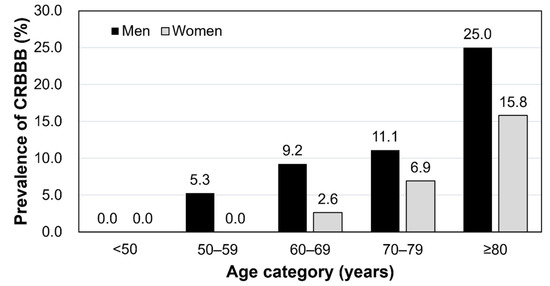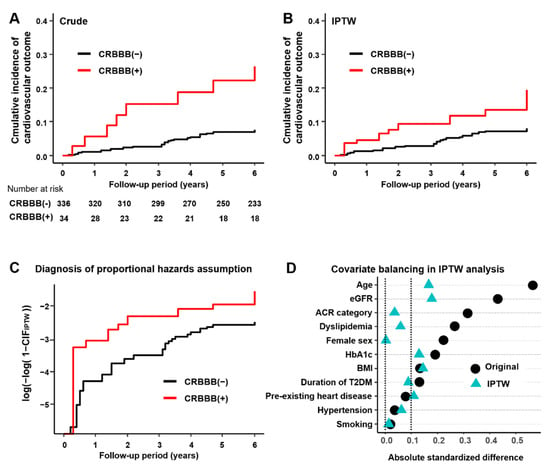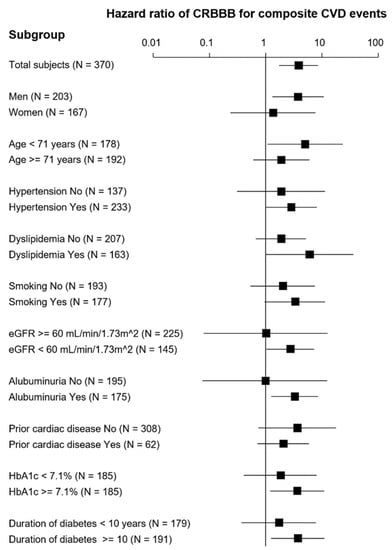Abstract
Complete right bundle branch block (CRBBB) is generally regarded as a clinically insignificant abnormality on an electrocardiogram, although its predictive value for cardiovascular events in type 2 diabetes mellitus (T2DM) is unknown. We examined the association of CRBBB with cardiovascular events during a 6-year follow-up in a single-center cohort study. The Fine–Gray model was used to analyze the independent association between CRBBB and composite cardiovascular events including cardiovascular death, nonfatal myocardial infarction, nonfatal stroke, and hospitalization for heart failure during follow up. We analyzed the data of 370 T2DM patients including 62 patients with pre-existing heart disease. CRBBB was found in 34 patients (9.2%). The composite cardiovascular outcome was recorded in 32 patients. When analyzed with the Fine–Gray model with inverse probability of treatment weighting, CRBBB was significantly associated with a higher risk of the cardiovascular outcome (hazard ratio, 2.55; 95% confidence interval, 1.04 to 6.26; p = 0.041). This association remained significant even after further adjustment for each of the potential confounders. This study suggested that CRBBB was an independent predictor of cardiovascular events in T2DM. Further studies with a larger sample size are warranted.
1. Introduction
Complete right bundle branch block (CRBBB) on an electrocardiogram, unlike left bundle branch block, has been generally regarded as a clinically insignificant finding in otherwise healthy individuals [1,2,3,4,5]. In contrast, some studies reported the significant association between CRBBB and cardiovascular events and mortality in patients with heart disease [6,7] and in people without cardiovascular disease [8,9]. These studies suggest that the prognosis of individuals with CRBBB may vary depending on the population. Such association has not been examined in patients with type 2 diabetes mellitus (T2DM). Since patients with T2DM are known to have a higher risk of both CRBBB [10] and cardiovascular events [11], we hypothesized that CRBBB could be predictive of cardiovascular events in patients with T2DM.
2. Materials and Methods
2.1. Study Design and Population
This is a single-center cohort study in prevalent T2DM patients. The inclusion criteria were (1) T2DM patients who were treated at the Department of Internal Medicine, Fujiidera Municipal Hospital, Fujiidera, Osaka, Japan on 1 January 2015; (2) patients who were examined with 12-lead electrocardiogram in 2014; and (3) patients whose clinical outcomes during the follow up until 1 January 2021 were available. No specific exclusion criteria were set.
2.2. Exposure and Outcome
The key exposure was the presence versus absence of CRBBB on the latest 12-lead electrocardiogram at rest taken in 2014. CRBBB was defined by the Minnesota Code criteria of a limb lead QRS duration of 0.12 s or more with an R’ greater than R or an R peak duration of 0.06 s or more in either lead V1 or V2 [1].
The outcome was composite cardiovascular events consisting of cardiovascular death (including fatal myocardial infarction, fatal stroke, death from heart failure, and sudden cardiac death), nonfatal myocardial infarction, nonfatal stroke, or hospitalization for heart failure during follow up from 1 January 2015 until 1 January 2021, collected by reviewing medical records.
2.3. Other Variables
Based on many previous studies, we collected data regarding age, sex, smoking, hypertension, dyslipidemia, pre-existing heart disease, body mass index (BMI), estimated glomerular filtration rate (eGFR), and albuminuria as potential confounders. The pre-existing heart disease included coronary heart disease, cardiomyopathy, left ventricular hypertrophy, valvular heart disease, left ventricular diastolic disorder, congenital heart disease, and atrial fibrillation. The duration of T2DM and HbA1c were also recorded as variables related to T2DM.
Smoking denotes current smoking. Hypertension was defined as systolic blood pressure ≥140 mmHg, diastolic blood pressure ≥90 mmHg, or use of any antihypertensive agent [12]. Dyslipidemia was defined as low-density lipoprotein cholesterol ≥120 mg/dL, triglyceride ≥150 mg/dL, high-density lipoprotein cholesterol <40 mg/dL, or use of any lipid-lowering medication [13]. BMI was calculated by body weight (kg) divided by squared height (m2). eGFR was calculated by the equation for the Japanese [14]. Albuminuria was categorized into normo-albuminuria, micro-albuminuria, and overt albuminuria [15]. Duration of T2DM and HbA1c were based on medical records.
2.4. Statistical Analysis
The baseline characteristics of the patients were summarized by number (%) for categorical variables and median (interquartile range) for continuous variables. Comparison between the two groups with and without CRBBB was done by Fisher’s exact test or Mann–Whitney’s U-test.
To investigate the association between CRBBB and the cardiovascular outcome, cumulative incidence functions (CIFs) for cardiovascular outcome were estimated using the Gray method, and incidence rates were compared between two groups with and without CRBBB using hazard ratio (HR) and 95% confidence interval (95% CI) from Fine–Gray analysis. Noncardiovascular death was considered as competing risk. To address the problem of confounding by the difference in background characteristics of groups, a propensity score approach was used. Propensity scores were estimated by logistic regression using the following background characteristics: age, sex, hypertension, dyslipidemia, smoking, pre-existing heart disease, eGFR, albuminuria, BMI, HbA1c, and duration of T2DM. The inverse probability of treatment weights (IPTWs) were then calculated based on the estimated propensity scores. The balances of patient background characteristics in the IPTW analysis were assessed by absolute standardized differences (ASDs). ASDs less than 0.1 were considered as balanced between groups [16]. IPTW-adjusted CIF and HR were estimated. The proportional hazard assumption for CRBBB on composite cardiovascular events was assessed by plotting the log of negative log(1−CIF).
Stratified analysis was conducted to examine whether some subgroups of patients were at higher or lower risk of cardiovascular events associated with CRBBB. Subgroups were stratified by sex, median age, the presence of hypertension, the presence of dyslipidemia, smoking status, eGFR (≥60, <60 mL/min/1.73 m2), the presence of albuminuria (≥30 mg/g creatinine), the presence of pre-existing heart disease, median HbA1c, and median duration of diabetes.
These statistical calculations were performed using JMP (version 14.3.0, SAS Institute, Tokyo, Japan), EZR (version 1.53), R (version 4.2.0), and SAS (version 9.4). EZR is a graphical interface for R (version 4.0.2, The R Foundation for Statistical Computing, Vienna, Austria) developed by Dr. Kanda, Saitama Medical Center, Jichi Medical University, Saitama, Japan [17].
3. Results
We analyzed data from 370 T2DM patients including 167 women (45.1%); median (interquartile range) of age, 71 (64 to 77) years. Among them, 62 patients had pre-existing heart disease. CRBBB was found in 34 out of the 370 patients (9.2%). As shown in Table 1, the group with CRBBB had a higher proportion of men, higher age, and lower eGFR, whereas the prevalence of pre-existing heart disease was not different between the two groups. As shown by Figure 1, the proportion of patients with CRBBB was higher in men and in higher age groups.

Table 1.
Characteristics of T2DM patients by CRBBB.

Figure 1.
Prevalence of CRBBB by sex and age category. The bar graph shows prevalence (percentage) of CRBBB by age and sex. Abbreviation: CRBBB, complete right bundle branch block.
During a median follow up of 6.0 years, composite cardiovascular events were recorded in 32 patients out of the total subjects. In the CRBBB (–) group, 24 patients experienced cardiovascular events (12 with cardiovascular death, 4 with nonfatal myocardial infarction, 3 with nonfatal stroke, and 5 with hospitalization for heart failure). In the CRBBB (+) group, eight patients experienced cardiovascular events (two with cardiovascular death, no one with nonfatal myocardial infarction, four with nonfatal stroke, and two with hospitalization for heart failure).
The crude association of CRBBB with the composite cardiovascular events was significant (Figure 2A, Table 2). This positive association remained significant after adjustment with IPTW (Figure 2B, Table 2). There was no clear violation of proportional hazard assumption for CRBBB on composite cardiovascular events based on the log of negative log(1−CIF) plot (Figure 2C). While the balances in patient background characteristics were generally improved by the IPTW method, small imbalances in age, eGFR, BMI, HbA1c, and pre-existing heart disease remained (Figure 2D). Therefore, we performed additional Fine–Gray analysis adjusting these characteristics in the model. The positive association remained significant even after this additional adjustment (Table 2).

Figure 2.
Association of CRBBB with cardiovascular events. (A) Crude cumulative incidence of the composite cardiovascular outcome with noncardiovascular death as a competing risk. (B) Cumulative incidence of the composite cardiovascular outcome with noncardiovascular death as a competing risk estimated by IPTW method. (C) Log of negative log(1−CIF) plot for the diagnosis of proportional hazards assumption of cumulative incidence estimated by IPTW method. (D) Assessment of covariate balancing in analysis by IPTW method. Abbreviations: CIF, cumulative incidence function; CRBBB, complete right bundle branch block.

Table 2.
Unadjusted and adjusted association of CRBBB with cardiovascular events in T2DM.
The results of stratified analysis are shown in Figure 3. The positive association between CRBBB and subsequent CVD events was not evident in some subgroups, particularly in women, those of older age (≥71 years), those with preserved kidney function, and those without albuminuria. In addition, the association was not significant in those without vascular risk factors such as hypertension, dyslipidemia, smoking, high HbA1c, and long duration of diabetes.

Figure 3.
Stratified analysis of the association of CRBBB with cardiovascular events. The figure gives hazard ratios and 95% confidence intervals for each group by IPTW-adjusted Fine–Gray model.
4. Discussion
This study is the first that reported CRBBB as an independent risk factor of cardiovascular events in a cohort of T2DM. This finding in T2DM may be important, since CRBBB is generally perceived as clinically insignificant [1,2,3,4,5].
Significant association of CRBBB with worse prognosis was reported by meta-analyses in patients with acute myocardial infarction [6,7] and patients with heart failure [6]. Of note, at least two large cohort studies revealed that CRBBB was associated with higher risk of cardiovascular disease and all-cause mortality in patients without known cardiovascular disease [9] and in the general population [8]. Thus, the degree of risk associated with CRBBB appears to vary depending on the populations. This study has added T2DM to the list of patient groups in which CRBBB predicts worse outcomes.
In our study, the association between CRBBB and cardiovascular risk in T2DM was significant in statistical models in which the effects of pre-existing heart disease and other potential confounders were considered, and the hazard ratios were similar between subgroups with and without pre-existing heart disease. These results suggest that the risk of cardiovascular events was elevated in individuals with CRBBB among T2DM patients regardless of pre-existing heart disease. Diabetic cardiomyopathy [18] is the concept that the myocardium is impaired by hyperglycemia, insulin resistance, advanced glycation end product accumulation, lipo-toxicity, activated renin–angiotensin–aldosterone system, oxidative stress, and other mechanisms. CRBBB in T2DM patients may be a sign of undiagnosed diabetic cardiomyopathy, which could be followed by clinically significant cardiovascular outcomes.
Stratified analysis indicated that the association between CRBBB and risk for subsequent CVD events was not evident in some subgroups such as women, those with older age, those without decreased eGFR, those without albuminuria, and those without vascular risk factors. These subgroups, excluding those with older age, are generally regarded to have a lower risk of CVD. It may be that CRBBB increases the risk of CVD in T2DM patients when vascular risk factors are present regardless of pre-existing heart disease and that such association is less evident in older patients.
This study has limitations including a retrospective design, a single-center observation in Japan, and its small sample size, whereas its strength includes careful statistical analysis using competing risk models and adjustment with IPTW.
5. Conclusions
In conclusion, this study suggests that CRBBB is an independent predictor of cardiovascular events in T2DM. Due to the small sample size of this cohort, further studies are needed to confirm and establish the predictive value of CRBBB in this population.
Author Contributions
K.O., investigation, writing—original draft, writing—review and editing; S.U., conceptualization, investigation, formal analysis, writing—original draft, writing—review and editing; M.M., investigation, writing—review and editing; N.H., investigation, writing—review and editing; K.M., writing—review and editing; T.M., writing—review and editing; T.I., formal analysis, writing—review and editing; T.S., formal analysis, writing—original draft, writing—review and editing; M.E., supervision, writing—review and editing. All authors have read and agreed to the published version of the manuscript.
Funding
This research received no external funding.
Institutional Review Board Statement
This study was conducted in accordance with the latest version of the Declaration of Helsinki and the Ethical Guidelines for Clinical Studies by the Ministry of Health, Labor, and Welfare, Japan. The protocol of this study was reviewed and approved by the ethics committee of Fujiidera Municipal Hospital (Approval No. 3–5, 16 June 2021).
Informed Consent Statement
Informed consent was obtained by the opt-out method. Written informed consent was waived due to the observational nature of this study.
Data Availability Statement
The data presented in this study are available on request from the corresponding author. The data are not publicly available due to ethics committee permission.
Acknowledgments
Part of this study was presented at the 65th Annual Meeting of Japan Diabetes Society in Kobe, Japan (13 May 2022), and the abstract in Japanese was published (Abstract Number II-84-1).
Conflicts of Interest
All authors declare nothing to disclose relevant to this study.
References
- Fleg, J.L.; Das, D.N.; Lakatta, E.G. Right bundle branch block: Long-Term prognosis in apparently healthy men. J. Am. Coll. Cardiol. 1983, 1, 887–892. [Google Scholar] [CrossRef] [Green Version]
- Fahy, G.J.; Pinski, S.L.; Miller, D.P.; McCabe, N.; Pye, C.; Walsh, M.J.; Robinson, K. Natural history of isolated bundle branch block. Am. J. Cardiol. 1996, 77, 1185–1190. [Google Scholar] [CrossRef]
- Eriksson, P.; Hansson, P.O.; Eriksson, H.; Dellborg, M. Bundle-branch block in a general male population: The study of men born 1913. Circulation 1998, 98, 2494–2500. [Google Scholar] [CrossRef] [PubMed] [Green Version]
- Miller, W.L.; Hodge, D.O.; Hammill, S.C. Association of Uncomplicated Electrocardiographic Conduction Blocks with Subsequent Cardiac Morbidity in a Community-Based Population (Olmsted County, Minnesota). Am. J. Cardiol. 2008, 101, 102–106. [Google Scholar] [CrossRef] [PubMed]
- Yeh, S.S.-F.; Chen, C.-Y.J.; Wu, I.-C.; Hsu, C.-C.; Chen, T.-Y.; Tseng, W.-T.; Tang, F.-C.; Wang, C.-C.; Juan, C.-C.; Chiu, H.-C.; et al. Prognostic value and prevalence of complete right bundle branch block in an elderly population: A community-based 10-year prospective study. Aging 2020, 12, 19073–19082. [Google Scholar] [CrossRef] [PubMed]
- Xiong, Y.; Wang, L.; Liu, W.; Hankey, G.; Xu, B.; Wang, S. The Prognostic Significance of Right Bundle Branch Block: A Meta-analysis of Prospective Cohort Studies. Clin. Cardiol. 2015, 38, 604–613. [Google Scholar] [CrossRef] [PubMed]
- Xiang, L.; Zhong, A.; You, T.; Chen, J.; Xu, W.; Shi, M. Prognostic Significance of Right Bundle Branch Block for Patients with Acute Myocardial Infarction: A Systematic Review and Meta-Analysis. Med. Sci. Monit. Int. Med. J. Exp. Clin. Res. 2016, 22, 998–1004. [Google Scholar] [CrossRef] [PubMed]
- Bussink, B.E.; Holst, A.G.; Jespersen, L.; Deckers, J.W.; Jensen, G.B.; Prescott, E. Right bundle branch block: Prevalence, risk factors, and outcome in the general population: Results from the Copenhagen City Heart Study. Eur. Heart J. 2013, 34, 138–146. [Google Scholar] [CrossRef] [PubMed] [Green Version]
- Gaba, P.; Pedrotty, D.; DeSimone, C.V.; Bonikowske, A.R.; Allison, T.G.; Kapa, S. Mortality in Patients With Right Bundle-Branch Block in the Absence of Cardiovascular Disease. J. Am. Heart Assoc. 2020, 9, e017430. [Google Scholar] [CrossRef] [PubMed]
- Jeong, J.H.; Kim, J.H.; Park, Y.H.; Han, D.C.; Hwang, K.W.; Lee, D.W.; Oh, J.H.; Song, S.G.; Kim, J.S.; Chun, K.J.; et al. Incidence of and Risk Factors for Bundle Branch Block in Adults older than 40 years. Korean J. Intern. Med. 2004, 19, 171–178. [Google Scholar] [CrossRef] [PubMed]
- Grundy, S.M.; Benjamin, I.J.; Burke, G.L.; Chait, A.; Eckel, R.H.; Howard, B.V.; Mitch, W.; Sowers, J.R.; Smith, S.C. Diabetes and cardiovascular disease: A statement for healthcare professionals from the American Heart Association. Circulation 1999, 100, 1134–1146. [Google Scholar] [CrossRef] [PubMed] [Green Version]
- Shimamoto, K.; Ando, K.; Fujita, T.; Hasebe, N.; Higaki, J.; Horiuchi, M.; Umemura, S.; Imai, Y.; Ito, M.; Itoh, H.; et al. The Japanese Society of Hypertension Guidelines for the Management of Hypertension (JSH 2014). Hypertens. Res. 2014, 37, 253–390. [Google Scholar] [PubMed] [Green Version]
- Kinoshita, M.; Yokote, K.; Arai, H.; Iida, M.; Ishigaki, Y.; Ishibashi, S.; Umemoto, S.; Egusa, G.; Ohmura, H.; Okamura, T.; et al. Japan Atherosclerosis Society (JAS) Guidelines for Prevention of Atherosclerotic Cardiovascular Diseases 2017. J. Atheroscler. Thromb. 2018, 25, 846–984. [Google Scholar] [CrossRef] [PubMed] [Green Version]
- Matsuo, S.; Imai, E.; Horio, M.; Yasuda, Y.; Tomita, K.; Nitta, K.; Yamagata, K.; Tomino, Y.; Yokoyama, H.; Hishida, A.; et al. Revised Equations for Estimated GFR From Serum Creatinine in Japan. Am. J. Kidney Dis. 2009, 53, 982–992. [Google Scholar] [CrossRef] [PubMed]
- Levey, A.S.; de Jong, P.E.; Coresh, J.; El Nahas, M.; Astor, B.C.; Matsushita, K.; Gansevoort, R.T.; Kasiske, B.L.; Eckardt, K.-U. The definition, classification, and prognosis of chronic kidney disease: A KDIGO Controversies Conference report. Kidney Int. 2011, 80, 17–28. [Google Scholar] [CrossRef] [PubMed] [Green Version]
- Austin, P.C. Balance diagnostics for comparing the distribution of baseline covariates between treatment groups in propensity-score matched samples. Stat. Med. 2009, 28, 3083–3107. [Google Scholar] [CrossRef] [PubMed] [Green Version]
- Kanda, Y. Investigation of the freely available easy-to-use software ‘EZR’ for medical statistics. Bone Marrow Transpl. 2013, 48, 452–458. [Google Scholar] [CrossRef] [PubMed] [Green Version]
- Jia, G.; Whaley-Connell, A.; Sowers, J.R. Diabetic cardiomyopathy: A hyperglycaemia- and insulin-resistance-induced heart disease. Diabetologia 2018, 61, 21–28. [Google Scholar] [CrossRef] [PubMed] [Green Version]
Publisher’s Note: MDPI stays neutral with regard to jurisdictional claims in published maps and institutional affiliations. |
© 2022 by the authors. Licensee MDPI, Basel, Switzerland. This article is an open access article distributed under the terms and conditions of the Creative Commons Attribution (CC BY) license (https://creativecommons.org/licenses/by/4.0/).